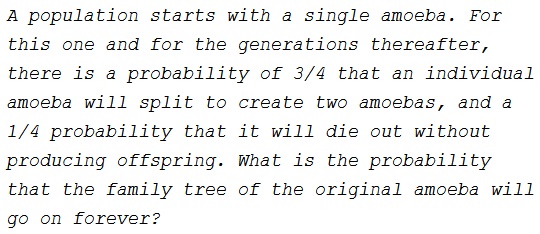Amoeba's Survival

|Contact| |Front page| |Contents| |Up|
Copyright © 1996-2018 Alexander Bogomolny
A population starts with a single amoeba. For this one and for the generations thereafter, there is a probability of 3/4 that an individual amoeba will split to create two amoebas, and a 1/4 probability that it will die out without producing offspring. What is the probability that the family tree of the original amoeba will go on forever?
The probability in question is 2/3. You can check the solution.
|Contact| |Front page| |Contents| |Up|
Copyright © 1996-2018 Alexander Bogomolny
Solution 1
A population starts with a single amoeba. For this one and for the generations thereafter, there is a probability of 3/4 that an individual amoeba will split to create two amoebas, and a 1/4 probability that it will die out without producing offspring. What is the probability that the family tree of the original amoeba will go on forever?
Good and general notations help solve the problem. Let p be the probability of a successful split for a single amoeba, and P the probability in question, the probability that an amoeba's family tree is infinite.
With the probability p we have a second generation of two amoebas. The probability that at least one of them will have an infinite family tree is
P = p(1 - (1 - P)2)
because both sides of the equation represent the probability of the long term survival to the original amoeba.
Simipification yields
pP2 + (1 - 2p)P = 0,
or
P·(pP + (1 - 2p)) = 0.
P may be 0 or, otherwise, satisfy the equation.
pP + (1 - 2p) = 0,
or
P = (2p - 1)/p.
By expermintal verification, if p > 1/2, there's a true population explosion that suggests that, in this case, P≠0. The formula we obtained also confirms that, if a generic amoeba divides with the probability not exceeding 1/2, it stands no chance to survive forever. However, for the specific case where
Remark
There's a nagging question whether relying on experimental results is a valid argument against $P=0.$ Let's modify the above a little. Let $P_n$ be the probability that the $n^{th}$ generation of amoebas is not empty. Then we have a recurrent relation:
$P_{n+1}=p\left(1-(1-P_n)^2\right).$
We shall prove by induction that $\displaystyle P_{n}\gt \frac{2p-1}{p}.$ First off, $P_0=1,$ as we a given that an amoeba is present at the outset. Let $\displaystyle P_{n}\gt \frac{2p-1}{p}.$ We proceed in several steps:
$\displaystyle \begin{align} &P_{n}\gt \frac{2p-1}{p}\\ &1-P_n\lt 1-\frac{2p-1}{p}=\frac{1-p}{p}\\ &(1-P_n)^2\lt \left(\frac{1-p}{p}\right)^2\\ &1-(1-P_n)^2\gt 1-\left(\frac{1-p}{p}\right)^2=\frac{2p-1}{p^2}\\ &P_{n+1}=p\left(1-(1-P_n)^2\right)\gt \frac{2p-1}{p}, \end{align}$
as promised.
Solution 2
(Chritopher D. Long)
This is a disguised biased random walk with an absorbing state at $0$ which starts at $1.$ If this random walk is at $N,$ considering $N$ moves corresponds to considering the fate of $N$ amoebas simultaneously. This yields $\displaystyle 1-\frac{1-p}{p} = 1-\frac{1/4}{3/4} = \frac{2}{3}$ by the usual arguments.
References
- R. Blum et al., Mathemagic, Main Street, 2002
|Contact| |Front page| |Contents| |Up|
Copyright © 1996-2018 Alexander Bogomolny
71535051
